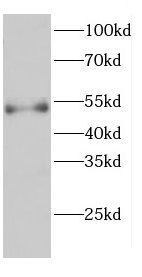Products
CARD9 antibody
| Size | Price |
|---|---|
| 100µg | Inquiry |
- SPECIFICATIONS
- FIGURES
- CONDITIONS
- FAQS
- Product Name
- CARD9 antibody
- Catalogue No.
- FNab01272
- Size
- 100μg
- Form
- liquid
- Purification
- Immunogen affinity purified
- Purity
- ≥95% as determined by SDS-PAGE
- Clonality
- polyclonal
- Isotype
- IgG
- Storage
- PBS with 0.02% sodium azide and 50% glycerol pH 7.3, -20℃ for 12 months(Avoid repeated freeze / thaw cycles.)
- Immunogen
- caspase recruitment domain family, member 9
- Alternative Names
- Caspase recruitment domain-containing protein 9 (hCARD9)|CARD9 antibody
- UniProt ID
- Q9H257
- Observed MW
- 50-59 kDa
- Tested Applications
- ELISA, WB
- Recommended dilution
- WB: 1:500-1:2000
 HL-60 cells were subjected to SDS PAGE followed by western blot with FNab01272( CARD9 Antibody) at dilution of 1:1500
HL-60 cells were subjected to SDS PAGE followed by western blot with FNab01272( CARD9 Antibody) at dilution of 1:1500
- Background
- Adapter protein that plays a key role in innate immune response to a number of intracellular pathogens, such as C.albicans and L.monocytogenes. Is at the crossroads of ITAM-tyrosine kinase and the Toll-like receptors(TLR) and NOD2 signaling pathways. Probably controls various innate immune response pathways depending on the intracellular pathogen. In response to L.monocytogenes infection, acts by connecting NOD2 recognition of peptidoglycan to downstream activation of MAP kinases(MAPK) without activating NF-kappa-B. Also involved in activation of myeloid cells via classical ITAM-associated receptors and TLR: required for TLR-mediated activation of MAPK, while it is not required for TLR-induced activation of NF-kappa-B(By similarity). Controls CLEC7A(dectin-1)-mediated myeloid cell activation induced by the yeast cell wall component zymosan, leading to cytokine production and innate anti-fungal immunity: acts by regulating BCL10-MALT1-mediated NF-kappa-B activation pathway. Activates NF-kappa-B via BCL10. In response to the hyphal form of C.albicans, mediates CLEC6A(dectin-2)-induced I-kappa-B kinase ubiquitination, leading to NF-kappa-B activation via interaction with BCL10. In response to fungal infection, may be required for the development and subsequent differentiation of interleukin 17-producing T helper(TH-17) cells.
How many times can antibodies be recycled?
First, usually it's not suggested to recycle antibodies. After use, buffer system of antibodies has changed. The storage condition of recycled antibodies for different customers also varies. Thus, the performance efficiency of recycled antibodies can’t be guaranteed. Besides, FineTest ever conducted the antibody recycling assay. Assay results show recycling times of different antibodies also varies. Usually, higher antibody titer allows more repeated use. Customers can determine based on experimental requirements.
Notes: After incubation, we recycle rest antibodies to centrifuge tube and store at 4℃. High titer antibodies can be stored for a minimum of one week. Reuse about three times.
What are components of FineTest antibody buffer?
Components of FineTest antibody buffer are usually PBS with proclin300 or sodium azide, BSA, 50% glycerol. Common preservative is proclin300 or sodium azide, which is widely applied in the lab and industry.
How about the storage temperature and duration of FineTest antibodies?
Most antibodies are stored at -20℃. Directly-labeled flow cytometry antibodies should be stored at 2 - 8℃. The shelf life is one year. If after sales issues for purchased antibodies appear, return or replacement is available. Usually, antibodies can be still used after the one-year warranty. We can offer technical support services.
Is dilution required for FineTest antibodies? What’s the dilute solution?
Directly-labeled flow cytometry antibodies are ready-to-use without dilution. Other antibodies are usually concentrated. Follow the dilution ratio suggested in the manual. Dilute solution for different experiments also varies. Common antibody dilution buffers are acceptable(e.g. PBST, TBST, antibody blocking buffer).
How to retrieve antibodies for immunohistochemistry?
Common retrieval buffers: Tris-EDTA Buffer(pH 9.0); Citrate Buffer(pH 6.0)
Heat induced antibody retrieval:
Method 1: Water-bath heating: Put the beaker with retrieval buffer and slide in the boiling water bath. Keep the boiling state for 15min. Naturally cool to room temperature;
Method 2: Microwave retrieval: Put the beaker with retrieval buffer and slide in the microwave oven. Heat at high power for 5min, Switch OFF for 3min, Heat at medium power for 5min. Naturally cool to room temperature.
How to choose secondary antibodies?
(1) Secondary antibodies react with primary antibodies. Thus, secondary antibodies should be against host species of primary antibodies. E.g. If the primary antibody is derived from rabbit, the relevant secondary antibody should be against rabbit. E.g. goat anti rabbit or donkey anti rabbit.
(2) Choose secondary antibody conjugates according to the experimental type, e.g. ELISA, WB, IHC etc. Common enzyme conjugated secondary antibodies are labelled by HRP, AP etc. Fluorescin or dye labelled secondary antibodies are applied in immunofluorescence and flow cytometry(e.g. FITC, Cy3).
